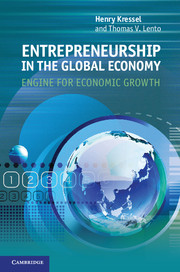Book contents
- Frontmatter
- Contents
- Figures
- Tables
- Acknowledgments
- Introduction
- 1 Government: Boss, financial partner, regulator – Entrepreneurs in mixed economies
- 2 Standing still is not an option: On promoting entrepreneurship and economic growth
- 3 Electronic innovation and the government: David Sarnoff creates the RCA empire
- 4 Global problem, golden opportunity: Ron Stanton profits from market disruption
- 5 Speeding voice and data traffic worldwide: Network microprocessors from RMI
- 6 A world leader emerges: SanDisk and flash memories
- 7 Implementing information technology across the globe
- 8 Three startups in China: Entrepreneurs in a controlled economy
- 9 Connecting the wireless networks of the world
- 10 Building an economy: Government planning vs. entrepreneurial innovation
- Select bibliography
- Index
- References
Introduction
Published online by Cambridge University Press: 05 August 2012
- Frontmatter
- Contents
- Figures
- Tables
- Acknowledgments
- Introduction
- 1 Government: Boss, financial partner, regulator – Entrepreneurs in mixed economies
- 2 Standing still is not an option: On promoting entrepreneurship and economic growth
- 3 Electronic innovation and the government: David Sarnoff creates the RCA empire
- 4 Global problem, golden opportunity: Ron Stanton profits from market disruption
- 5 Speeding voice and data traffic worldwide: Network microprocessors from RMI
- 6 A world leader emerges: SanDisk and flash memories
- 7 Implementing information technology across the globe
- 8 Three startups in China: Entrepreneurs in a controlled economy
- 9 Connecting the wireless networks of the world
- 10 Building an economy: Government planning vs. entrepreneurial innovation
- Select bibliography
- Index
- References
Summary
Innovation is a primary engine of economic growth … The innovation process involves the invention, commercialization, and diffusion of new ideas. At each of these stages, people are spurred to action by the prospect of reaping rewards from their investment. In a free market, innovators vie to lower the cost of goods and services, to improve their quality and usefulness, and – most importantly – to develop new goods and services that promise benefits to customers … Successful innovations blossom, attracting capital and diffusing rapidly through the market, while unsuccessful innovations can wither just as quickly. In this way, markets allow capital to flow to its highest-valued uses.
President Bush’s 2005 report on the economy (quoted above) identifies innovation as the prime driver of economic development. And while Democrats and Republicans might disagree on how to promote it, innovation is officially a bipartisan cause. The Obama administration trumpets the need to foster innovation if America is to maintain its leading position among the world’s economies.
Joseph Alois Schumpeter would be gratified. The great twentieth-century Austrian-American economist was the foremost theorist of innovation as the source for economic growth in the industrial world. Schumpeter knew that all technologies eventually became obsolete, and according to his theory this presented an opportunity for change and growth that could only be realized with innovation. In his view the decline of older technologies makes room for new ones. Through a process he called “creative destruction,” innovation enables vibrant new enterprises to replace obsolete industries.
- Type
- Chapter
- Information
- Entrepreneurship in the Global EconomyEngine for Economic Growth, pp. 1 - 10Publisher: Cambridge University PressPrint publication year: 2012



